glove box OLDSMOBILE SILHOUETTE 2003 Owners Manual
[x] Cancel search | Manufacturer: OLDSMOBILE, Model Year: 2003, Model line: SILHOUETTE, Model: OLDSMOBILE SILHOUETTE 2003Pages: 466, PDF Size: 21.55 MB
Page 87 of 466
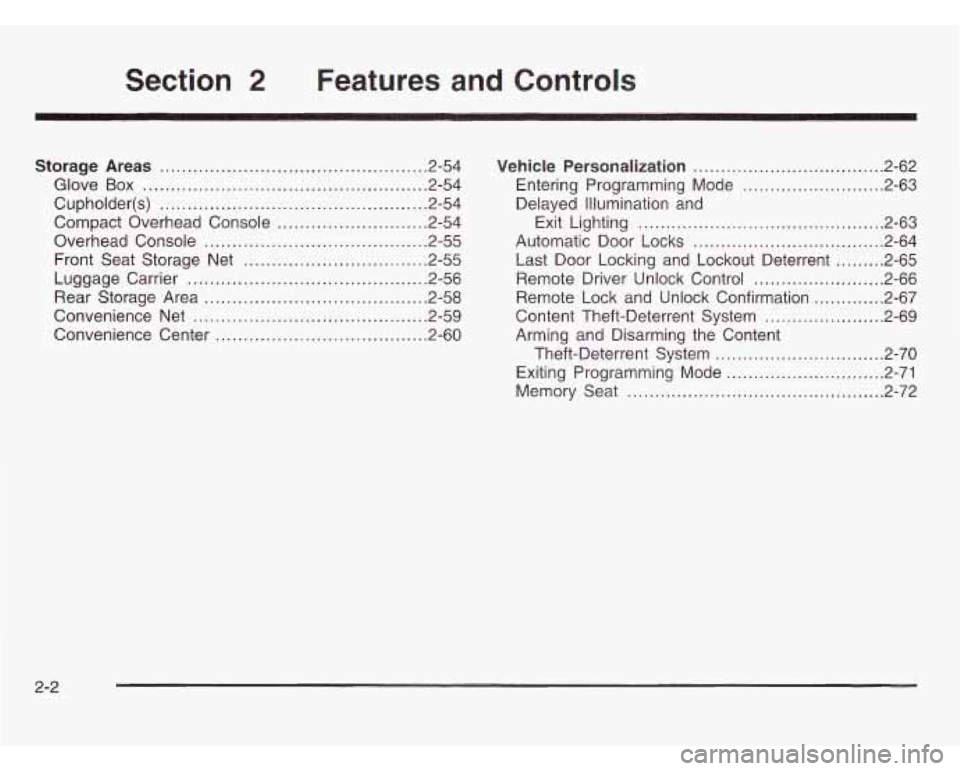
Section 2 Features and Controls
Storage Areas ................................................ 2.54
Glove
Box ................................................... 2.54
Cupholder(s)
................................................ 2.54
Compact Overhead Console
........................ 2.54
Overhead Console
................. ................ 2.55
Front Seat Storage Net
...... ................... 2.55
Luggage Carrier
........................................... 2.56
Rear Storage Area
........................................ 2.58
Convenience Net
.......................................... 2.59
Convenience Center
...................................... 2.60 Vehicle Personalization
.................................
Entering
Programming Mode ........................
Delayed Illumination and
Exit Lighting
...........................................
Automatic Door Locks .................................
Last Door Locking and Lockout Deterrent .......
Remote Driver Unlock Control ......................
Remote Lock and Unlock Confirmation ...........
Content Theft-Deterrent System ....................
Arming and Disarming the Content
Theft-Deterrent System
.............................
Memory Seat .............................................
Exiting Programming Mode ...........................
. 2.62
. 2.63
. 2.63
. 2.64
. 2.65
. 2.66
. 2.67
. 2.69
. 2.70
. 2.71
. 2.72
2-2
Page 132 of 466
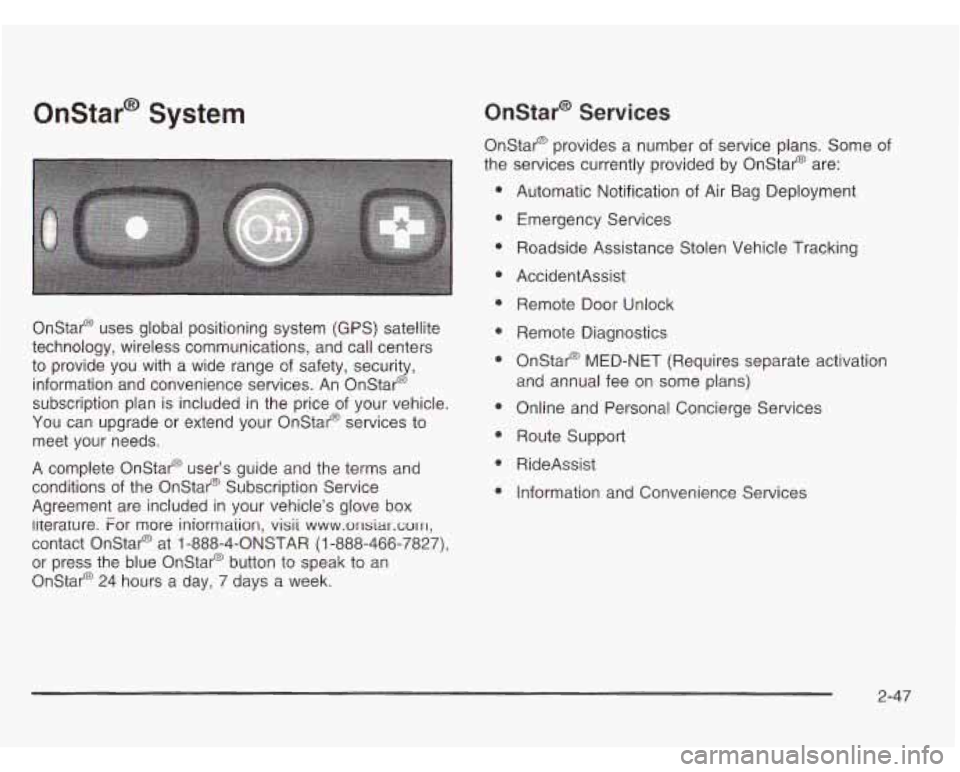
Onstar@ System Onstar@ Services
Onstar@ Drovides a number of service plans. Some of
the services currently provided by OnStap are:
e
Onstar@ uses global positioning system (GPS) satellite
technology, wireless communications, and call centers
to provide you with a wide range
of safety, security,
information and convenience services. An Onstar@
subscription plan is included in the price of your vehicle.
You can upgrade or extend your Onstar@ services to
meet your needs.
A complete OnStap user’s guide and the terms and
conditions
of the Onstar@ Subscription Service
Agreement are included
in your vehicle’s glove box
iiterature. For more iniormaiion, visii
www.msiar.cwrl,
contact Onstar@ at 1 -888-4-ONSTAR (1 -888-466-7827),
or press the blue Onstar@ button to speak to an
Onstar@ 24 hours a day, 7 days a week. Automatic Notification
of Air Bag Deployment
Emergency Services
Roadside Assistance Stolen Vehicle Tracking
AccidentAssist Remote Door Unlock
Remote Diagnostics
Onstar@ MED-NET (Requires separate activation
and annual fee on some plans)
Online and Personal Concierge Services
Route Support
RideAssist
Information and Convenience Services
2-47
Page 133 of 466
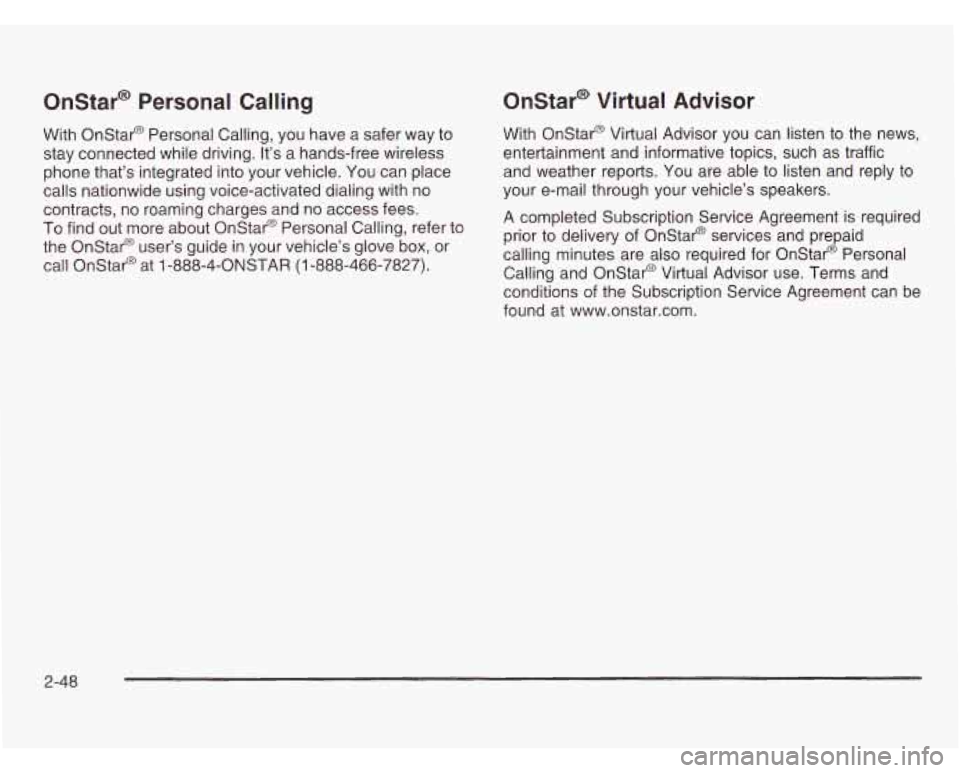
Onstar@ Personal Calling
With Onstar@ Personal Calling, you have a safer way to
stay connected while driving.
It’s a hands-free wireless
phone that’s integrated into your vehicle. You can place
calls nationwide using voice-activated dialing with no
contracts, no roaming charges and no access fees.
To find out more about Onstar@ Personal Calling, refer to
the Onstar@ user’s guide in your vehicle’s glove box, or
call Onstar@ at
1 -888-4-ONSTAR (1 -888-466-7827).
Onstar@ Virtual Advisor
With Onstar@ Virtual Advisor you can listen to the news,
entertainment and informative topics, such as traffic
and weather reports. You are able to listen and reply to
your e-mail through your vehicle’s speakers.
A completed Subscription Service Agreement is required
prior to delivery of Onstar@ services and prepaid
calling minutes are also required for Onstar@ Personal
Calling and Onstar@ Virtual Advisor use. Terms and
conditions of the Subscription Service Agreement can be
found at www.onstar.com.
2-48
Page 139 of 466
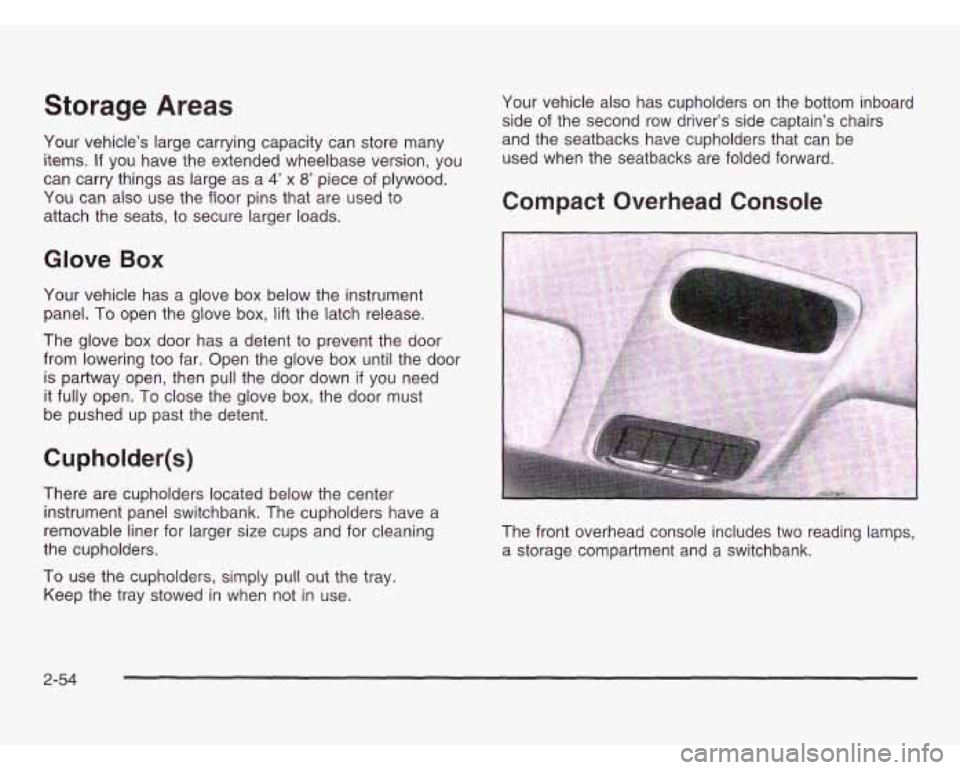
Storage Areas
Your vehicle's large carrying capacity can store many
items.
If you have the extended wheelbase version, you
can carry things as large as a
4' x 8' piece of plywood.
You can also use the floor pins that are used to
attach the seats, to secure larger loads.
Glove Box
Your vehicle has a glove box below the instrument
panel.
To open the glove box, lift the latch release.
The glove box door has a detent to prevent the door
from lowering too far. Open the glove box until the door
is partway open, then pull the door down if you need
it fully open. To close the glove box, the door must
be pushed up past the detent.
Cupholder(s)
There are cupholders located below the center
instrument panel switchbank. The cupholders have a
removable liner for larger size cups and for cleaning
the cupholders.
To use the cupholders, simply pull out the tray.
Keep the tray stowed in when not in use. Your
vehicle also has cupholders on the bottom inboard
side of the second row driver's side captain's chairs
and the seatbacks have cupholders that can be
used when the seatbacks are folded forward.
Compact Overhead Console
The front overhead console includes two reading lamps,
a storage compartment and a switchbank.
2-54
Page 148 of 466
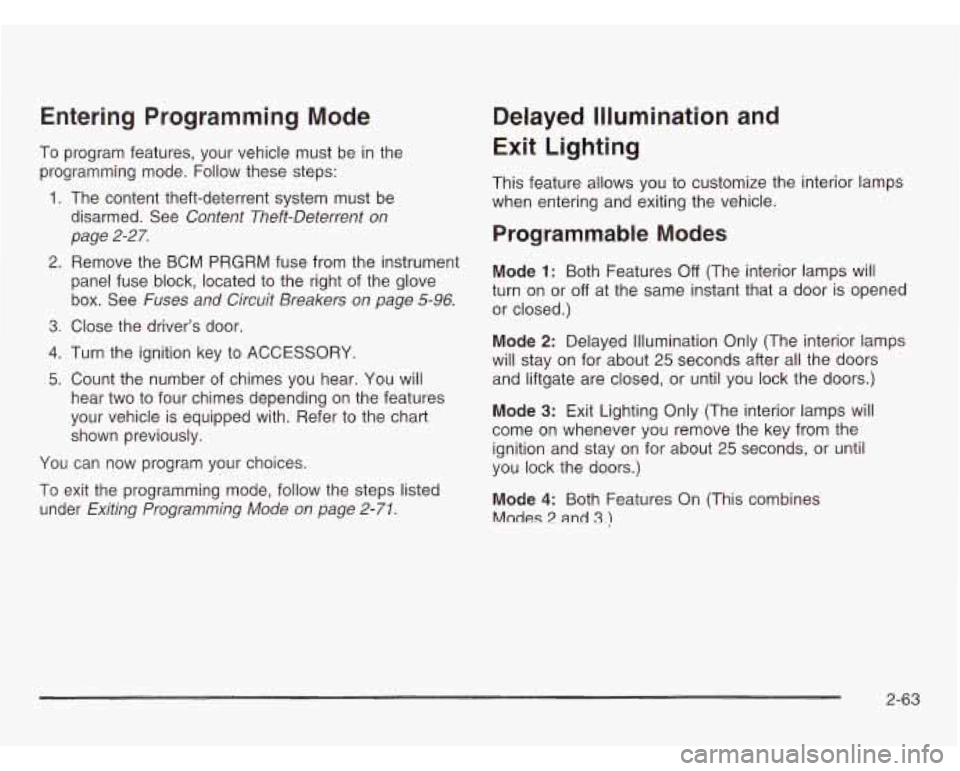
Entering Programming Mode
To program features, your vehicle must be in the
programming mode. Follow these steps:
1. The content theft-deterrent system must be
disarmed. See
Content Theft-Deterrent on
page
2-27.
2. Remove the BCM PRGRM fuse from the instrument
panel fuse block, located to the right of the glove
box. See Fuses and Circuit Breakers on page 5-96.
3. Close the driver’s door
4. Turn the ignition key to ACCESSORY.
5. Count the number of chimes you hear. You will
hear two to four chimes depending on the features
your vehicle is equipped with. Refer to the chart
shown previously.
You can now program your choices.
To exit the programming mode, follow the steps listed
under
Exiting Programming Mode on page 2-71.
Delayed Illumination and
Exit Lighting
This feature allows you to customize the interior lamps
when entering and exiting the vehicle.
Programmable Modes
Mode 1: Both Features Off (The interior lamps will
turn on or
off at the same instant that a door is opened
or closed.)
Mode
2: Delayed Illumination Only (The interior lamps
will stay on for about
25 seconds after all the doors
and liftgate are closed, or until you lock the doors.)
Mode
3: Exit Lighting Only (The interior lamps will
come on whenever you remove the key from the
ignition and stay on for about
25 seconds, or until
you lock the doors.)
Mode
4: Both Features On (This combines
Modes 2 and 3.)
2-63
Page 162 of 466
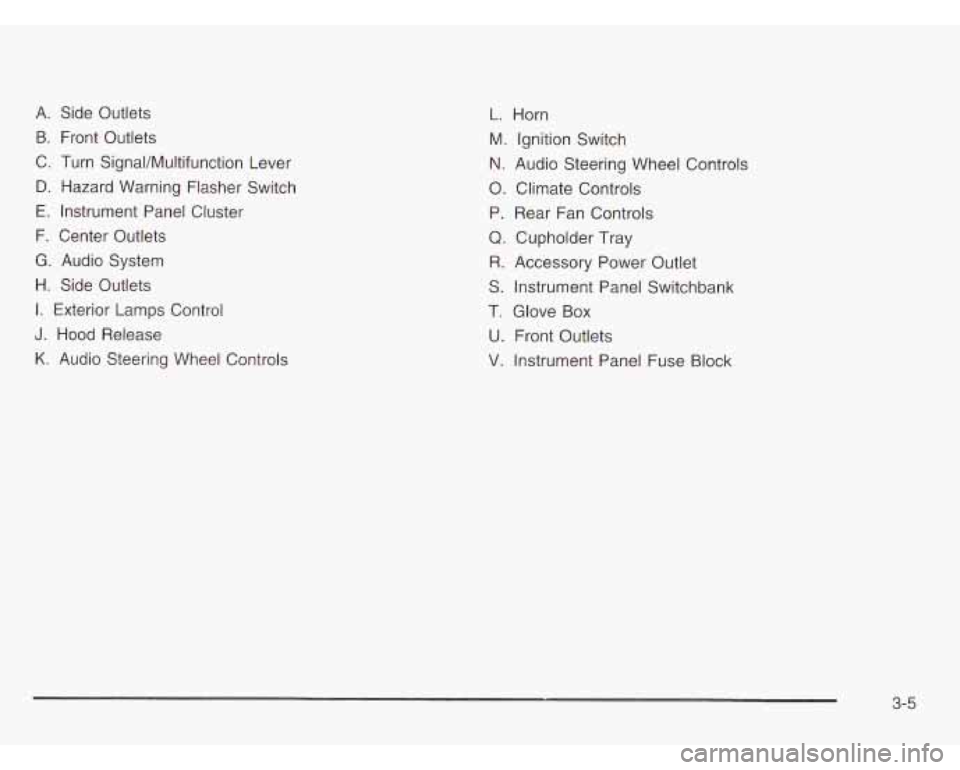
A. Side Outlets
B. Front Outlets
C. Turn SignaVMultifunction Lever
D. Hazard Warning Flasher Switch
E. Instrument Panel Cluster
F. Center Outlets
G. Audio System
H. Side Outlets
I. Exterior Lamps Control
J. Hood Release
K. Audio Steering Wheel Controls
L. Horn
M. Ignition Switch
N. Audio Steering Wheel Controls
0. Climate Controls
P. Rear Fan Controls
Q. Cupholder Tray
R. Accessory Power Outlet
S. Instrument Panel Switchbank
T. Glove Box
U. Front Outlets
V. Instrument Panel Fuse Block
3-5
Page 194 of 466
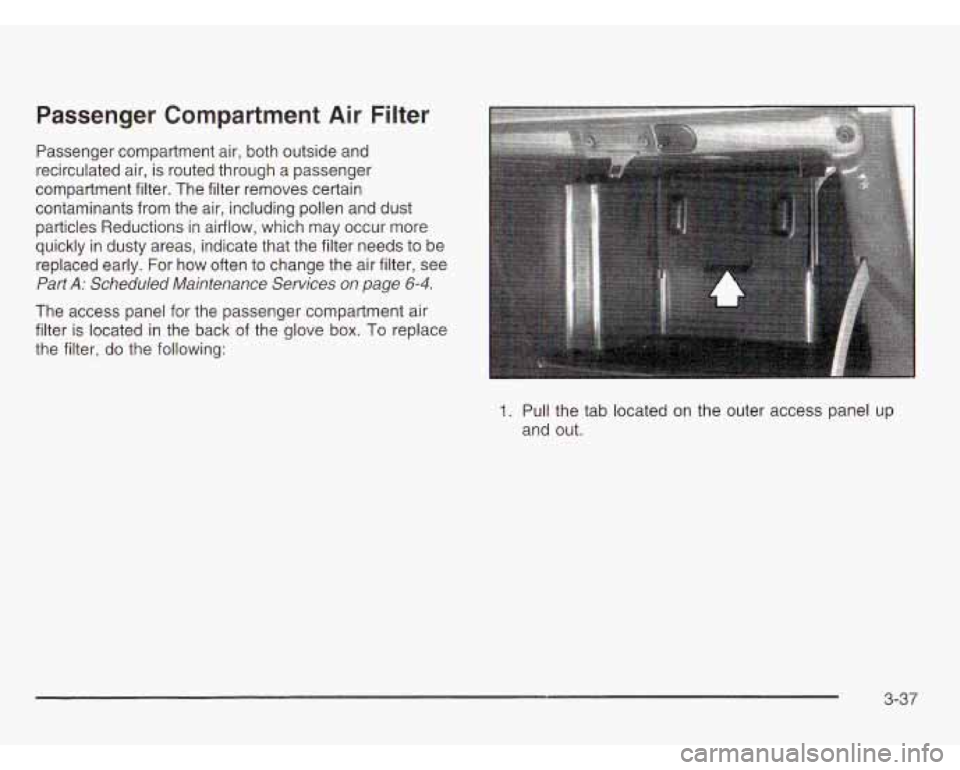
Passenger Compartment Air Filter
Passenger compartment air, both outside and
recirculated air, is routed through a passenger
compartment filter. The filter removes certain
contaminants from the air, including pollen and dust
particles Reductions in airflow, which may occur more
quickly in dusty areas, indicate that the filter needs to be
replaced early. For how often to change the air filter, see
Part A: Scheduled Maintenance Services on page 6-4.
The access panel for the passenger compartment air
filter is located in the back of the glove box. To replace
the filter, do the following:
1. Pull the tab located on the outer access panel up
and out.
3-37
Page 195 of 466
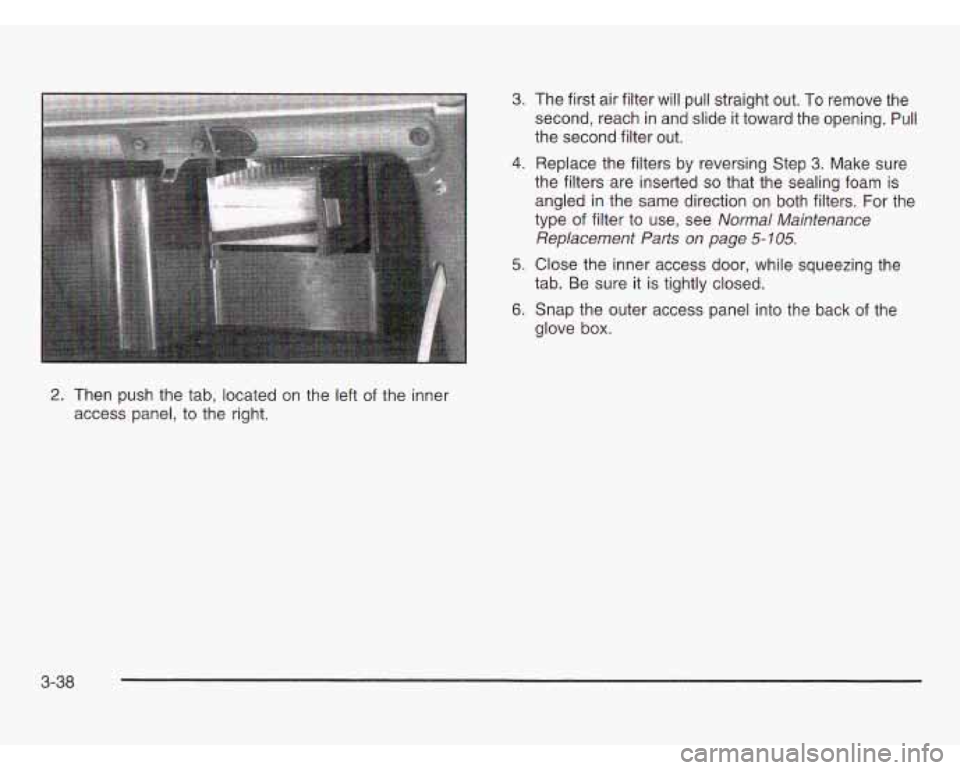
2. Then push the tab, located on the left of the inner
access panel, to the right.
3. The first air filter will pull straight out. To remove the
second, reach in and slide it toward the opening.
Pull
the second filter out.
4. Replace the filters by reversing Step 3. Make sure
the filters are inserted
so that the sealing foam is
angled in the same direction on both filters. For the
type of filter
to use, see Normal Maintenance
Replacement Parts on page
5- 105.
5. Close the inner access door, while squeezing the
6. Snap the outer access panel into the back of the
tab.
Be sure it is tightly closed.
glove box.
3-38
Page 375 of 466
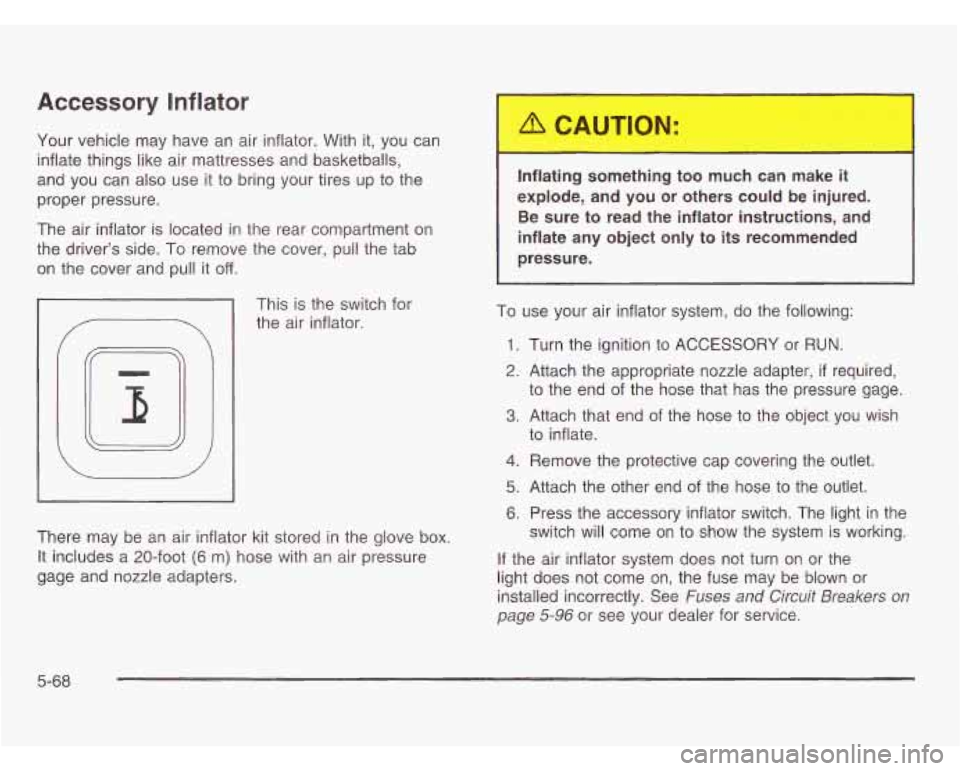
Accessory Inflator
Your vehicle may have an air inflator. With it, you can
inflate things like air mattresses and basketballs,
and you can also use it to bring your tires up to the
proper pressure.
The air inflator is located in the rear compartment on
the driver’s side. To remove the cover, pull the tab
on the cover and pull it
off.
This is the switch for
the air inflator.
There may be an air inflator kit stored in the glove box.
It includes a 20-foot
(6 m) hose with an air pressure
gage and nozzle adapters.
....___ ting something too much can make it
explode, and you or others could be injured.
Be sure to read the inflator instructions, and
inflate any object only
to its recommended
pressure.
To use your air inflator system, do the following:
1. Turn the ignition to ACCESSORY or RUN.
2. Attach the appropriate nozzle adapter, if required,
to the end
of the hose that has the pressure gage.
3. Attach that end of the hose to the object you wish
to inflate.
4. Remove the protective cap covering the outlet.
5. Attach the other end of the hose to the outlet.
6. Press the accessory inflator switch. The light in the
switch will come on to show the system is working.
If the air inflator system does not turn on or the
light does not come on, the fuse may be blown or
installed incorrectly. See
Fuses and Circuit Breakers on
page 5-96 or see your dealer for service.
5-68
Page 376 of 466
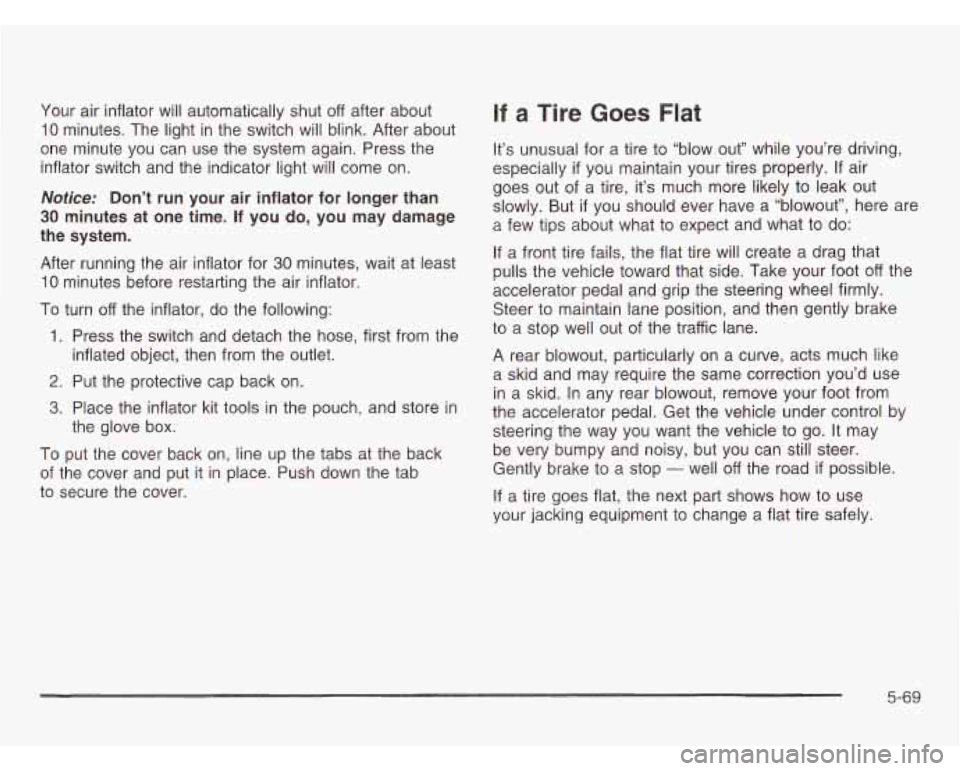
Your air inflator will automatically shut off after about
10 minutes. The light in the switch will blink. After about
one minute you can use the system again. Press the
inflator switch and the indicator light will come on.
Notice: Don’t run your air inflator for longer than
30 minutes at one time. If you do, you may damage
the system.
After running the air inflator for
30 minutes, wait at least
10 minutes before restarting the air inflator.
To turn off the inflator, do the following:
1. Press the switch and detach the hose, first from the
2. Put the protective cap back on.
3. Place the inflator kit tools in the pouch, and store in
inflated
object, then from the outlet.
the glove box.
To put the cover back on, line up the tabs at the back
of the cover and put it in place. Push down the tab
to secure the cover.
If a Tire Goes Flat
It’s unusual for a tire to “blow out” while you’re driving,
especially
if you maintain your tires properly. If air
goes out of a tire, it’s much more likely to leak out
slowly. But if you should ever have a “blowout”, here are
a few tips about what to expect and what to do:
If a front tire fails, the flat tire will create a drag that
pulls the vehicle toward that side. Take your foot
off the
accelerator pedal and grip the steering wheel firmly.
Steer to maintain lane position, and then gently brake
to a stop well out of the traffic lane.
A rear blowout, particularly on a curve, acts much like
a skid and may require the same correction you’d use
in a skid. In any rear blowout, remove your foot from
the accelerator pedal. Get the vehicle under control by
steering the way you want the vehicle to go. It may
be very bumpy and noisy, but you can still steer.
Gently brake to a stop
- well off the road if possible.
If a tire goes flat, the next part shows how to use
your jacking equipment to change a flat tire safely.
5-69